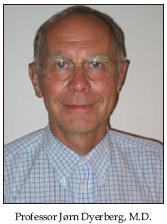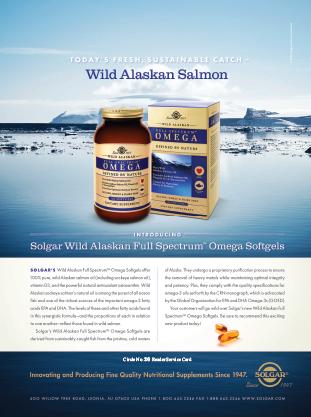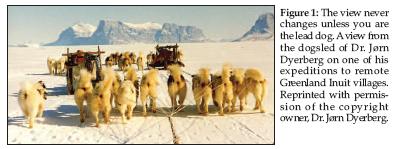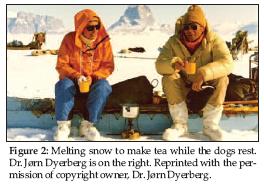 Reduce your chance of dying a sudden death by 45% (1, 2)! Reduce your risk of dying from sudden cardiac death by 90% (3). Reduce your chance of developing Alzheimer’s disease by 45–50% (4). Stay younger longer (5, 6)! Reduce the inflammation and pain of rheumatoid arthritis and the pain of osteoarthritis arthritis and other inflammatory diseases (7, 8). The litany of health benefits from omega-3s goes on, but hopefully, these are enough to get your attention so that you will read on about this miraculous dietary supplement. We will discuss the details of these studies in a later installment of this series.
Reduce your chance of dying a sudden death by 45% (1, 2)! Reduce your risk of dying from sudden cardiac death by 90% (3). Reduce your chance of developing Alzheimer’s disease by 45–50% (4). Stay younger longer (5, 6)! Reduce the inflammation and pain of rheumatoid arthritis and the pain of osteoarthritis arthritis and other inflammatory diseases (7, 8). The litany of health benefits from omega-3s goes on, but hopefully, these are enough to get your attention so that you will read on about this miraculous dietary supplement. We will discuss the details of these studies in a later installment of this series.
Recently, a low level of long-chain omega-3 fatty acids had been purposed as a risk factor for heart disease. The new risk factor is based on measuring the fatty acids in red blood cells, and is expressed as a percentage of EPA + DHA of total fatty acids. An omega-3 index of >8% is associated with 90% less risk for sudden cardiac death, as compared to an omega-3 index of <4%.
Admittedly, to some, omega-3s are starting to sound a bit old. What could be new about them? Plenty! And, of course, since everyone knows about them now, it’s hard to envision that it took a small handful of brilliant and dedicated scientists to discover their importance to human health.
Modern mankind is deficient in the omega-3 fatty acid nutrients. In recent years, the biologically functional omega-3 fatty acids in fish oil, eicosapentaenoic acid (EPA) and docosahexaenoic acid ( DHA), have been the second-most important dietary supplement, ranking just behind general purpose multis (multivitamins and minerals). Now, it seems that in a couple of market segments, fish oil supplements have become the leading supplement.
The Nielsen Company, a market research firm, reports that sales of omega-3 products showed a 42% growth in 2009 (9). ConsumerLab.com reported in February that fish oil/omega-3 supplements were used by 74% of respondents of their survey (up from 71.6% in 2008), followed in popularity by multivitamins, which were used by 72% (down from 73.8% in the prior year) (10).
The popularity of fish oils is largely due to their health benefits and convenience of supplemental form. Fish are important in the diet, but difficult to include often enough for maximum benefit. Also, the purity of refined fish oils allows more of the important omega-3s to be consumed without the burden of the impurities of whole fish, which include mercury and PCBs.
Nearly everyone in the civilized world knows of at least some of the health benefits of these marine lipids. EPA and DHA are primarily found in cold-water fish, but it seems that few people, aside from scientists, know of the primary discoverer of these health benefits, Jørn Dyerberg, M.D. The story has been more than 40 years in the making and he had to go to nearly the end of the earth to uncover it. His complete research is well-deserving of a Nobel Prize.
Several billions of people live and have lived on this planet and yet relatively few have ventured deep into the Arctic Circle. Nor have they made a major health study that betters the health of millions of people. Dr. Dyerberg has done both.

Dr. Dyerberg, professor and Dr. Med.Sc., has made several discoveries that elucidate many of the health benefits of omega-3 fish oils. Dr. Dyerberg made five scientific expeditions to Northwest Greenland examining the association between fish oil intake and coronary heart diseases in Eskimos. Dr. Dyerberg, who is Danish, hypothesized that the rarity of coronary heart disease among the Inuit population could be due to the omega-3 fatty acids in their diet consisting largely of seal and cold-water oily fish. Together with his fellow researchers, he went on to elucidate the unique physiological effects of these fatty acids. His research opened new fields leading to thousands of health studies by many. His own research encompasses more than 350 scientific publications primarily concerning blood lipids, atherosclerosis, the blood coagulation system, omega-3 polyunsaturated fatty acids, trans-fatty acids and prostaglandins.
In 2007, Dr. Dyerberg was honored by the American Heart Association in “Recognition of Outstanding Scientific Contribution for the Advancement of Heart Health Worldwide.” In 2008, he received the American Dietetic Association Foundation’s Edna and Robert Langholtz International Nutrition Award. Hopefully, the Nobel Prize committees are studying his research.
Dr. Dyerberg has served as chief physician and head at the Aalborg hospital. He has been a professor in Copenhagen since 2001 and is currently a medical and scientific advisor to Napro-Pharma Ltd. (Norway) and Unilabs Ltd. (Denmark).
Passwater: Dr. Dyerberg, I first learned of your research in 1981 thanks to a visit to my laboratory by Dr. Tom Sanders of Queen Elizabeth College in London. He was aware of my writings questioning the prevalent thinking that heart disease was simply a matter of eating too much cholesterol and he thought that I would be interested in your seminal findings. He told me about your forays to Greenland and showed me your 1971 to 1981 publications. This meeting led to my writing of the first book on fish oils in 1982, called EPA—Marine Lipids (11).
The first thought that went through my mind was, “What in the world were you doing in the cold, cold Arctic when you could be working in a nice warm clinic or laboratory.” I could envision you and your colleagues riding dog sleds and trying to convince the Inuits to give you blood samples.
So, let’s start at the beginning. Dr. Dyerberg, why did you want to become a physician in the first place?
Dyerberg: I have never had any other idea for my professional life than to be a doctor. During my studies and the first two to three years after, I aimed at becoming a specialist in medicine (internist). In the course of that, I was appointed to Dr. H.O. Bang’s laboratory in Aalborg Denmark, where I was fascinated by the research possibilities that position offered. After a period at the pediatric and neurological departments, I returned to the clinical-chemical specialty with Dr. Bang, a decision I have never regretted, and I have spent the whole of my professional career in that specialty.
Passwater: Okay, then why did you travel to the end of the earth to study the health of the Greenland Inuits?
Dyerberg: It started in 1968 when an editorial appeared in the Danish Medical Society’s weekly journal, pointing at the unusual pattern of diseases among our Danish co-citizens in Greenland, the Eskimos or Inuits as they are called today. The anonymous author stated that it was an obligation for Danish researchers to study this issue “before it was too late,” meaning before westernization of the Inuit society took over.
Passwater: Even though Greenland is some distance from Denmark—actually being in North America while Denmark is in Europe—Greenland had been an “autonomous country” within the Kingdom of Denmark and thus many Danes had settled there.
Dyerberg: Yes. Among the many differences between the Greenland Eskimos’ disease pattern and the Danes’ disease pattern (including Eskimos who moved to Denmark) were that the Greenland Eskimos had a surprisingly low death rate from heart diseases, in spite of the fact that their traditional diet was based on seal and fish and consequently rather high in animal fat. Animal fat is considered by many to be a risk factor for coronary heart disease due to the increase in blood cholesterol. The Eskimo findings appeared to be paradoxical.
Passwater: You say surprisingly low. Wasn’t it only about a tenth—just 10%—of the U.S. rate of heart disease?
Dyerberg: Yes, we computed the death rates from coronary heart disease and found that the age standardized death rate for males aged 45–65 years in Greenland at that time was 5.3% compared to 40.4% in the United States. At that time, I was a resident physician in Dr. Bang’s laboratory. Dr. Bang had visited Greenland in the 1950s during a measles epidemic, and suggested that we should go to Greenland to examine the Eskimo’s blood lipids using an analytical method I had developed for my Ph.D. thesis for measuring lipoproteins in blood, a method that could be performed under field conditions (12). We managed to collect a modest sum of money to finance the trip, and together with a laboratory technician, we made our first Greenland expedition in 1970.
Passwater: A strong analytical background is important to scientific discovery. I have had the opportunity as a director of an analytical research laboratory to help many scientists, even Nobel Prize winners, use advanced analytical tools to help elucidate their discoveries.
You used the word, “expedition.” I doubt that in 1970 you could just go out with a load of scientific equipment and catch a plane to a remote Eskimo village. In 1981, when I first read your research papers, I envisioned you traveling by dogsled. Am I right?

Dyerberg: Yes, as you can see by these photos from our later expedition in 1976. The first (see Figure 1) shows a view from the sled as we were sledding 100 miles on the sea ice to Igdlorssuit. The name of the village translates to “The Big Houses.” Perhaps you recognize the word “igloo” in it. Igdlorssuit was a settlement with 100 inhabitants and approximately 800 dogs.
Passwater: It seems that everyone needs eight huskies to power their sled. The photo makes me feel cold just looking at it. It also reminds me of the old motivational expression that “the view changes only for the lead dog.”
I would guess that the only “experience” most of our North American readers have with dog sledding is from seeing TV news reports of the Great Iditarod Sled Race. We may have some readers in the northern states and Canada who have actually taken joyrides on dogsleds for short distances for recreation near where they live. However, very few of our readers have taken a real dogsled expedition across the frozen tundra and frozen sea. What most of our readers normally see on the news is a bunch of excited dogs barking happily at the start of the race.
Dyerberg: The experience of dog sledding all depends on the weather! We were happy to do the two long tours on sea ice from the main city Uummannaq to the settlement Igdlorssuit (now called Illorsuit) about 100 kilometers to the north. Uummannaq is a town of 1,500 people today and is the northernmost ferry point. Igdlorssuit is directly north over the sea ice of the Uummannaq Fjord. We had blue skies during the days of the midnight sun during our travel. The temperature ranged from about –10 to –20 degrees Celsius (minus four to plus 14 degrees Fahrenheit) and low wind. That makes such the experience perfect. In harsh weather, it can be quite the opposite. At that time, dog sledding was the only transportation available in winter time. Now, I believe they have snow scooters.
Passwater: Wise planning! The only time I was above the Arctic Circle was in North Finland in October 1993 and I was not so fortunate. I was there during the period when it was mostly dark and very much colder than I like. My hosts from the University of Jyvaeskylae took us north on a side-trip and we had a long and happy celebration to help us deal with the darkness and weather.
How about the dogs?
Dyerberg: When you start out, the dogs are eager and barking, but they quiet down as they have to do hard work for a long time—the tour took 10–12 hours, with two to three stops for making tea and feeding the dogs. The behavior of the dogs depends solely on the driver. We had experienced Eskimos as drivers, but of course we also tried to run the pack, but in vain. You have to know the commands and to use the whip to direct the dogs, and both are plain impossible. It is rather slow driving, the dogs cannot run fast with a heavy sled (we brought a lot of gear) and you are asked to run along with the sled now and then to ease the dogs’ burden. This is not easy as we were in a dress that does not invite running, as you can see from my photos. You do not stop for fishing; the sea ice was 1.5 meters when we sledded the approximately 100 km each way on it. There are some unpleasant issues as well, but there was no other way of getting the research done.
One of the dogs in each pack is the boss, which he rather often has to state, so both while sledding and resting there are often fights, which often leaves the lines entangled and “soiled.” It can be quite a job for the driver to disentangle them with his bare hands and often with the help of his teeth!
We were hungry when we reached our destination and glad to enjoy some Eskimo food.
Pass water: Well, maybe it wasn’t as “glamorous” as I envisioned. This second photo (Figure 2) shows that at least you could stop to rest occasionally. That must be you on the right.
water: Well, maybe it wasn’t as “glamorous” as I envisioned. This second photo (Figure 2) shows that at least you could stop to rest occasionally. That must be you on the right.
Dyerberg: Yes, here we are taking a rest for both the dogs and the people. Yes, I am on the right on the sled having a cup of warm tea sitting next to our technician. That is a primus stove at our feet for melting snow and boiling water for our tea.
Passwater: I guess it is either water or tea made from melting the snow. Any other drinks would be too heavy and bulky to carry by dogsled.
Dyerberg: Right. In this April 1976 expedition, we were collecting food items in winter time from the Eskimos. There were eight of us on eight dogsleds. There were Dr. Bang, myself, two technicians for preparing the samples, a practical guy, a dietician for doing food interviews, Dr. Hugh Sinclair from England and an expedition leader Ivars Silis—a later well-known arctic photographer—and 88 huskies.
We stayed and worked at Igdlorssuit for about four weeks and returned to Uummannaq the same way. From there, we took a boat down to Srd. Stromfiord and flew back to Denmark.
Passwater: At the time, did you sense you were on an adventure or just working?
Dyerberg: We knew that we had data that had never been collected before, but we had at that time no idea of the magnitude of our findings. The omega-3 concept was still some years ahead of us.
Passwater: Studying a people’s diet is one thing, but you started with blood samples. What were you looking for?
Dyerberg: We collected blood from 130 Eskimos in a fasting state, returned to Denmark, analyzed their blood lipids and lipoproteins and published the results in The Lancet in April 1971 (13).
Passwater: Even though the word “omega-3” was not mentioned in that seminal paper, it was the birth of the omega-3 story, and the study has since been classified as a “Nutrition Classic.”
Dyerberg: We found, in spite of their high-fat diet, that the Eskimos had favorable blood lipid levels. Yes, their cholesterol levels were lower than what we found in Danes, however their blood cholesterol levels were not low enough to explain the marked difference in heart attacks compared with Danes and Americans, thus we had to look for further explanations.
Since we realized that it was unlikely anyone would ever be able to reach these people again before their diet and lifestyle were altered due to the changes being brought about by modern travel and accessibility improvements, we felt it was our duty to analyze and publish as much as we could before it was too late. We used everything at our disposal including an old gas chromatograph in our lab. At least in the future, others would be able to know as much about 1970-era Eskimo blood lipid profiles as we could determine with our 130 blood samples.
Passwater: If it was already an old chromatograph in the early 1970s, it must have been a single-column instrument without temperature programming and without capillary columns. That would have really been a difficult analysis. So, you expanded beyond gel electrophoresis and your procedure for lipoproteins. In the 1970s, gas chromatographs and other analytical instruments were not as sophisticated or as fast as they are today. What could you hope to find other than the most basic blood evaluations?
Dyerberg: We were just testing for everything we knew about, but we did notice a couple of extra peaks in the fatty acid analysis of the blood samples—peaks that we had never seen before.
Passwater: Aha! Mystery compounds X and Y. Very interesting. If you didn’t happen to have the proper separation column and instrument settings, you may never have detected those extra peaks.
For our readers not familiar with gas chromatography, the different peaks represent the presence of different compounds as they elute from the separation column over time. So, here you were finding an indication of compounds never seen in human blood samples before. They were in the blood of Eskimos currently living in Greenland, but not in Eskimos who had moved to Denmark.
Dyerberg: Yes, we didn’t know what compounds they indicated, but it was reasonable to believe that they were fatty acids.
Passwater: But, you had to know just what these mystery compounds were for sure. Where did they come from? Could they be related to heart disease? If so, how?
Let’s take a pause and resume our chat next month. Stay tuned, readers, to learn how Dr. Dyerberg solved these riddles. WF
References
1. Dietary Supplementation With N-3 Polyunsaturated Fatty Acids And Vitamin E After Myocardial Infarction: Results Of The GISSI-Prevenzione Trial. Gruppo Italiano per lo Studio della Sopravvivenza nell’Infarto miocardico.
2. C.M. Albert, et al., “Blood Levels of Long-Chain N-3 Fatty Acids and the Risk of Sudden Death,” N. Engl. J. Med. 346 (15), 1113–1118 (2002).
3. H. Leon, et al., “Effect of Fish Oil on Arrhythmias and Mortality: Systematic Review,” BMJ 337, a2931 (2008).
4. E.J. Schaefer, et al., “Plasma Phosphatidylcholine Docosahexaenoic Acid Content and Risk of Dementia and Alzheimer Disease: The Framingham Heart Study,” Arch. Neurol. 63 (11), 1545-1550 (2006).
5. R. Farzaneh-Far, et al., “Association of Marine Omega-3 Fatty Acid Levels with Telomeric Aging in Patients with Coronary Heart Disease,” JAMA 303 (3), 250–257.
6. R. Farzaneh-Far, et al., “Telomere Length Trajectory and its Determinants in Persons with Coronary Artery Disease: Longitudinal Findings from the Heart and Soul Study,” PLoS One 5 (1), e8612.
7. B. Galarraga, et al., “Cod Liver Oil (N-3 Fatty Acids) as a Non-Steroidal Anti-Inflammatory Drug Sparing Agent in Rheumatoid Arthritis,” Rheumatol (Oxford) 47, 665–669 (2008).
8. D. Fritsch, et al., “A Multicenter Study of the Effect of Dietary Supplementation with Fish Oil Omega-3 Fatty Acids on Carprofen Dosage in Dogs with Osteoarthritis,” J. Amer. Veterinary Medical Assoc. 236 (5), 535–539 (2010).
9. S. Starling, “Nielsen: Omega-3 Sales Grow 42 Percent,”www.nutraingredients-usa.com/content/view/print/275814, accessed Feb. 1, 2010.
10. ConsumerLab.com Newsletter Feb. 1, 2010, http://view.email.
consumerlab.com/?j=fe54177877610d757611&m=fef61d78716705&ls=fde910737d6103747010717d&l=fe651670746d067f7613&s=fe2e107576600d7f711670&jb=ffcf14&ju=fe2c1670766601787c1d70&r=0
11. R.A. Passwater, EPA—Marine Lipids (New Canaan, CT, Keats Publishing, 1982).
12. J. Dyerberg and N. Hjorne, “Quantitation of the Lipoprotein Complex by Agarose Gel Electrophoresis,” Clin Chim Acta 33 (2), 458–461 (1971).
13. H.O. Bang, et al., “Plasma Lipid and Lipoprotein Pattern in Greenlandic West-Coast Eskimos,” Lancet 1 (7710), 1143–1145 (1971).
Published in WholeFoods Magazine, June 2010










